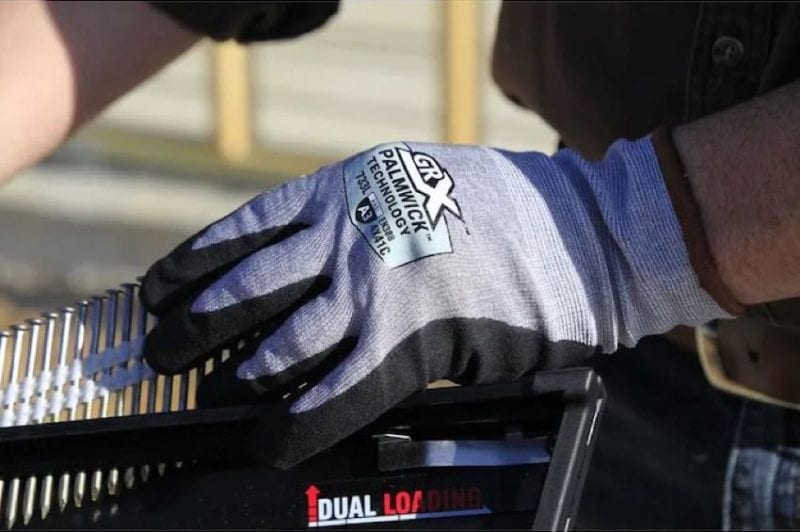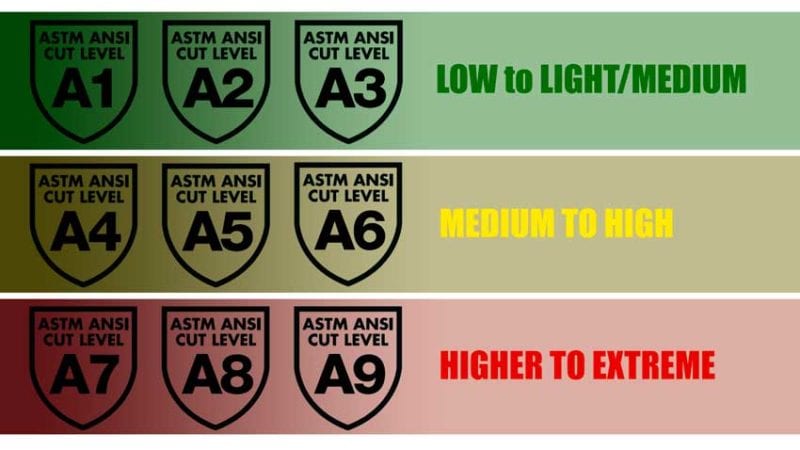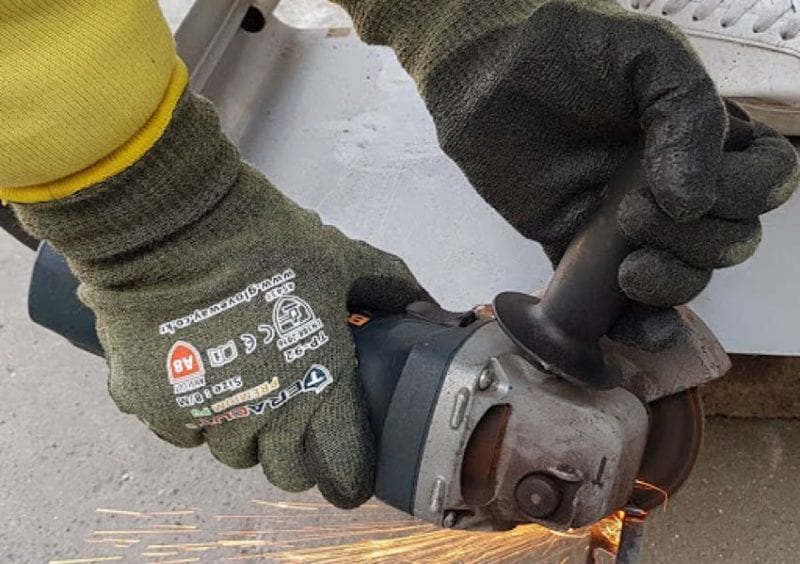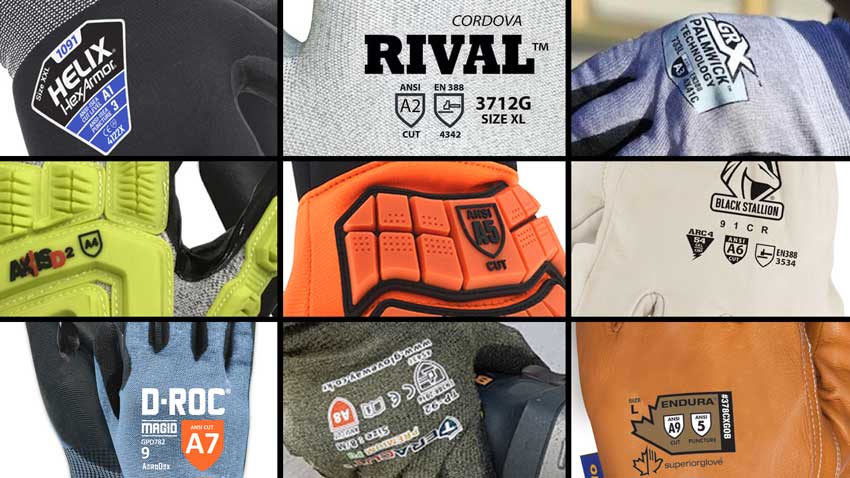ANSI/ISEA adjusted their cut resistance standards in 2016 to reflect new technological changes in materials and techniques. The adjusted ANSI glove ratings for cut resistance expand the old system from 5 total to 9 different levels. In the past, the Level 4 cut rating had a huge range—from 1500 to 3499 grams of cut protection. Obviously, you could have had ANSI Cut Level 4 protective gloves in the past that would behave very differently depending on which end of the scale they fell.
Now, the new 9-level scale seems to do a much better job of distributing those cut protection levels throughout the entire range. It can still seem a bit confusing, however. So let’s break it down.
Check out our article on types of work gloves for even more handy tips and tricks
2016 ANSI Glove Ratings with Cut Levels from A1–A9
The 2016 ANSI cut level ratings indicate how many grams of cutting load a glove can withstand from a sharp blade before it gets penetrated. To understand what each level might be good for, we’ve listed them below and added some descriptions of what might
A1: 200–499 grams (Low Cut Hazards)
ANSI A1 Cut Level gloves work well for light cut hazards. That means general material handling of wood or plastics as well as assembly tasks. When you need to handle small parts, an A1 glove provides the most amount of dexterity possible. A1 gloves can handle basic objects with sharp edges. That’s provided they don’t intersect the glove with more than 499 grams of force. Warehouse workers and anyone in the forestry or general construction trades can benefit from using these gloves.
A2: 500–999 grams (Light Cut Hazards)
Where ANSI A2 cut protection helps is anywhere you might encounter things like pulp and paper that could produce a cut. It also helps with automotive assembly since you may deal with sharp edges on parts and materials during handling.
A3: 1000–1499 grams (Light/Medium Cut Hazards)
A3 cut-rated gloves offer more of the same. They ramp up the amount of force these gloves can handle with respect o sharp objects. These gloves start to get into the more common category where you can expect reasonable protection when dealing with sharp edges and accidental contact with blades during normal handing.

A4: 1500–2199 grams (Medium Cut Hazards)
For metal fabrication and handling, gloves with an ANSI A4 cut level rating form the baseline of what you might want to look for. We also like these gloves for anyone working in food preparation or processing. When you think about it, anyone who might have to handle knives on a regular basis should take a look. It also helps for packaging and appliance manufacturing and well as bottle and light glass handling or canning.
With heavy razor knife use, drywallers, electricians, and carpet installers might also want to step up to an A4 or higher work glove. Finally, because of the sharp edges found in sheet metal, HVAC technicians and installers definitely want their hands protected when assembling and working with these systems.

A5: 2200–2999 grams (Medium/High Cut Hazards)
ANSI cut level ratings of A5 or higher indicate work gloves that simply ramp up the A4 level. This (obviously) provides slightly better protection. We don’t have much more to say other than a comfortable A5 glove definitely provides increased protection for tradesmen handling sharp metals and blades on a daily basis.
A6: 3000–3999 grams (High Cut Hazards)
If you handle dangerous or sharp materials all day long, an A6 cut-rated glove might help out. You may also find it mandatory depending upon where you work! These gloves work well in meat processing plants. We also recommend it for anywhere you deal with metal stamping or recycling. If you work on automatic and semi-automatic slitting blade machines, these gloves protect your hands when changing out the blades. Those dealing with glass & window manufacturing or sorting in recycling plants also want to consider an A5 cut-resistant glove.
A7: 4000–4999 grams (Higher Cut Hazards)
OK, ANSI glove ratings above A6 start to get serious. An A7 work glove carries enough cut protection to stop a nearly-5000 gram piece from puncturing or slicing your hand. You start to see interesting technologies with these gloves. Examples include the integration of 13-gauge seamless knit cut-resistant fiber technology and premium crinkle latex coatings. These gloves may be anti-microbial or even made of a thicker goatskin leather or leather-like material. They may also include liners for the palm and/or back of the hand.
A8: 5000–5999 grams (Highest Cut Hazards)
Often ANSI A8-level cut protection gloves include a lot more impact resistance as well. You may find additional palm reinforcement with high levels of abrasion resistance. It’s not uncommon to see full impact exterior glove protection to guard against serious impacts.
With these ANSI glove ratings, breathability becomes very important. Thicker, denser gloves require advanced fabric technology to remain maneuverable and tactile. These gloves typically fit well with those in the oils & gas industry or anyone involved in mining, demolition, or heavy equipment operation. It goes without saying that large glass-cutting operations might also benefit from gloves that have this level of ANSI cut level protection.

A9: 6000+ grams (Extreme Cut Hazards)
ANSI glove cut level ratings max out at A9. This level simply delivers more of the same. Unless you plan on handling sharks with metal mesh gloves—this is where you top out! Typically, A9 gloves come across as bulky and with a bit more padding than A1-A7 gloves. Even with knitted gloves, the coatings and integrated cut-protection fibers make these gloves a bit thicker and far less tactile than most.
Key Takeaways for ANSI Glove Ratings
Possibly the biggest takeaway for understanding ANSI glove ratings has to do with application. For some, your employer will tell you exactly which glove to use—some even supply them. For others, the rating may matter more—and the style of glove comes down to preference.
If you’re new to the job—ask around. We can almost guarantee others have gone through the learning process already. That could save you a lot of time and headache experimenting with the wrong kind of glove. Hopefully, this helps you on your way. If you have additional feedback for us—or any tips you’d like to contribute, please add them in a comment below!
Learn more about ANSI glove ratings at the ANSI website .


